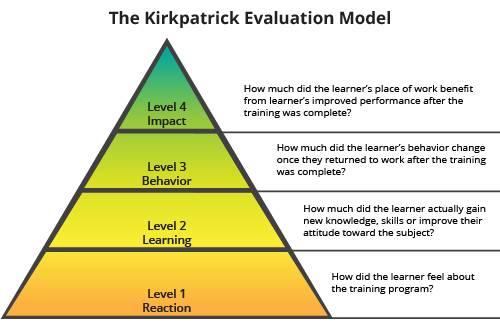Behavior Assessment
Title: Behavior Assessment
Client: Course Assignment
Made with: Adobe InDesign and Adobe Acrobat
Time in Development: ~6 hours
Collaborators: Solo-Project
Download the full document: Behavior Assessment
Background:
The Kirkpatrick Model recognized as the standard in training and learning programs evaluation. Created by Donald Patrick in 1959, and then updated in 1975 and 1993, the model can help instructional designers understand and quantify how effective their courses are. The Kirkpatrick model is divided into four levels which is often visualized using a pyramid. It can be used to assess formal and informal training methods and looks at four criteria levels: reaction, behavior, learning, and results.

This Behavior Assessment is associated to Level 3: Behavior.
The third level of evaluation measures how well the learners can apply what they learned. Assessing this behavior change makes it possible to understand if the material was understood and, more importantly, how much the student is applying what they learned at their work or within their function.
Some examples of Level 3 questions might be:
- Are you using what you learned in class at your workplace?
- Are their noticeable changes in your job performance since completing the training?
- Are there obstacles present which are preventing you from fully utilizing your newly learned skills?
Solution:
This twelve (12) question evaluation was written to for the learners to complete within just a couple minutes. The first four (4) questions are descriptive and ask how long and how often the learners have been practicing the skill being taught (in this case yoga).
The next six (6) questions are Likert Scale questions which ask how comfortable the learner is with newly learned aspects of yoga. The range given for each is:
- Not comfortable at all
- Slightly comfortable
- Fairly comfortable
- Fully comfortable
- No improvement
- Slightly improvement
- Medium improvement
- Substantial improvement
Ultimately, these questions would be delivered to actual yoga students using a means other than this type of presentation. They could easily be delivered as a questionnaire or survey in an app or other electronic means. For the purposes of presenting the questions here I built a full color, four (4) page, letter size (8.5″ wide by 11″ tall) and exported as a PDF which was then remediated for Section 508 compliance. The questions are simple, easy to digest, and would result in a good amount of data which would lead instructional designers to know if their training is effective in changing the behavior of the learners.